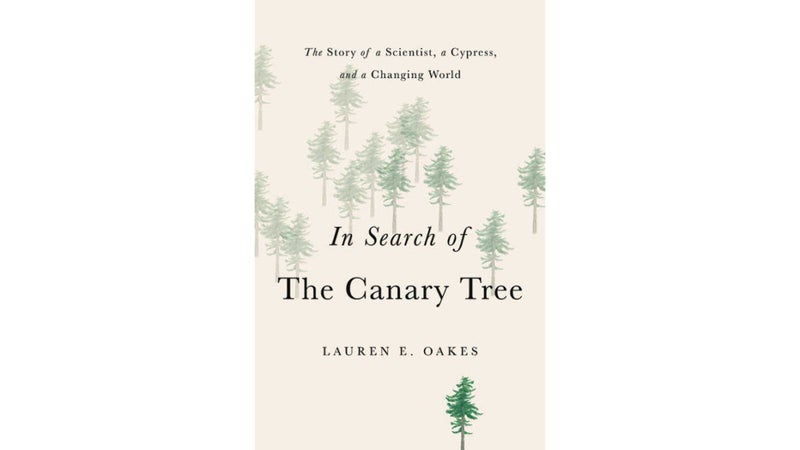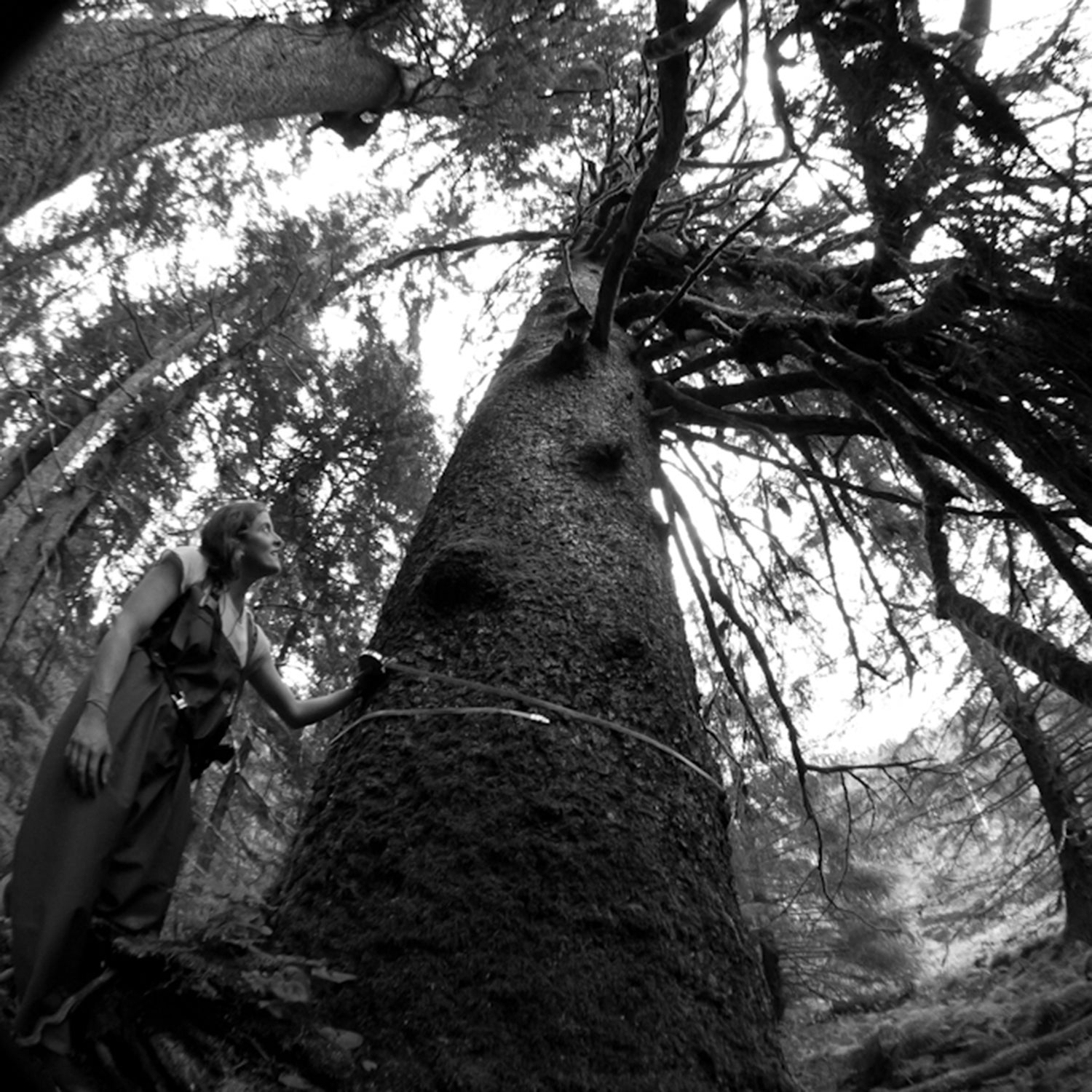There’s been much talk among scientists of late about��. What’s needed to convey scientific findings to the public, they say, is a device to isolate the signal from the noise: a good old-fashioned plotline.
Enter ecologist Lauren E. Oakes and ��($27, Basic Books), a debut effort in which she storifies the five years of research that earned her a doctorate in 2015 from Stanford University’s Emmett Interdisciplinary Program in Environment and Resources. Part memoir and part adventure yarn,��with pen and ink illustrations by Kate Cahill, Oakes’s book is an attempt to put a human face on hard science.
She transports the reader from Stanford’s gladed campus to southeast Alaska’s temperate rainforest, where she braves brown bears, rough seas, and thickets of devil’s club to survey 50 stands of Callitropsis nootkatensis.��Otherwise known as the Alaskan yellow-cedar, the species has been slowly succumbing to climate change in the lower latitudes of the Alexander Archipelago. Archetypal characters guide��her—call it the fellowship of the growth ring—consisting of��wise elders, eccentric helpers, and even an old man of the forest,��the Yoda-like Greg Streveler, who counsels��her to pay heed to that which cannot be measured. She comes away from the yellow-cedar��killing fields with a fundamentally altered view about what it means to be a scientist in the Anthropocene: “I didn’t want to become an ecologist to monitor a living species to extinction, write it up for a journal, and move on to the next study,” she writes.
So she didn’t.
Call it the human-plant interface, the canary in the book’s title. As goes the yellow-cedar, so go we.
Taking Streveler’s advice, Oakes observes the built and natural landscapes of southeast Alaska for six years to determine how both human and plant communities will cope with the cedar’s departure. First she uses environmental science to quantify��the yellow-cedar’s dieback and succession (cataloging metrics like tree height and canopy density). Next��she employs��social science (interviews, mainly) in the frontcountry to gauge the local citizens’ reactions to the tree’s decline. Call it the human-plant interface, the canary in the book’s title. As goes the yellow-cedar, so go we.
In one pivotal scene, essentially a hack into the book’s thesis, Oakes interviews the late Teri Rofkar, a Tlingit weaver, who says it plain: while the earth will persevere, climate change will go hard on humanity until we find some way to cooperate—and soon.

That conversation takes place years after Oakes��had surveyed 40 low-elevation stands of dead and dying yellow-cedars on the outer coast of Chichagof Island and other places��farther north in , where the trees still flourish. The yellow-cedar, Oakes explains, has survived southeast Alaska’s harsh winters for millennia, thanks to snow blanketing its roots and the annual release of a kind of antifreeze throughout its vasculature—a process called dehardening. But early-season thaws effectively drain the antifreeze, and rain falls in the lower elevations where snow once did. When cold snaps follow, the trees freeze to death.
Yet for Oakes, the yellow-cedar is an emblem of survival. She describes how the trees “migrate,” their seedlings finding tenacious purchase in widely scattered ecological pockets that seem promising for survival, an adaptive predilection scientists can’t quite explain. Humans similarly adapt, observes Oakes, especially when they work together toward a common cause. “We see what goes on and adapt for thousands of years,” Ernestine Hanlon-Abel, a Chilkat weaver from Hoonah, tells Oakes. In the 1700s, the Glacier Bay Tlingit people fled the advance of the Little Ice Age by relocating south, to Chichagof Island, and settled the village of Hoonah.
Change and loss: Oakes isn’t exempt. She quotes her field journal: “We are constantly working to stay warm, to access our sites, paddling, hiking, scrambling, hanging bear bags, hollering, measuring… Middle of the night, waking to hunger pangs.” She shuttles between wilderness and modernity with the accompanying angst.��Her boyfriend dumps her��by sat phone.��“What do you mean ‘you can’t do this thing,’” Oakes asks. “This thing,” replies the boyfriend. “Like us.” At that moment, a brown bear emerges from the bush. “I��gotta go,” says Oakes. “Hey bear. Heyyyyy bear.” She stands her ground, avoids eye contact, and survives the encounter.��
Then one evening, back in Palo Alto, she learns that her father has died. In shock, she runs into a rainy night in her socks, toward a cliff fronting the Pacific Ocean. A faceless man carrying a sleeping bag emerges from the shadows of a Monterey pine, which is��distantly related to the yellow-cedar. He stops, and they silently regard one another, but her gaze moves to the tree.��“I traced the shadow of the trunk back to the tree and looked up toward its branches. They fanned out in layers with their flat tops reaching for the sea,” she writes. But when��the man takes��a step forward, she thinks,��What am I doing? Go home.��She does��and reaches a “white picket fence, a familiar fence that bordered a yard a couple blocks from home.”��This is a rich scene, an exploration of the shear zone between the frontier and civilization, wilderness and society: despite our yearning for the former, we’ve disrupted and abused it—both the land and its Indigenous settlers. Now we’re impelled to return to the latter, which is where, perhaps, the hard work of reconciliation and the way forward begins.
The yellow-cedar’s prognosis? Overall, not good.
If the book’s central plot device is Oakes’s maturation as a scientist, then the plot suffers as she shifts her inquiry from the wild fringe of the Pacific to the homes that border it. We miss scenes of the near hypothermic Oakes and her ragtag team battling the elements in the name of science: here her dialogue with academics and tribal elders, although intimate and vulnerable, seems to have been lifted straight from the interview transcripts. Action turns to reflection as Oakes recapitulates the themes with which we’ve already become familiar, such as��loss, regeneration, connection to landscape, cooperation, adaptation, and hope.��Oakes seems to be using the book less as a cudgel than a rhetorical vehicle to answer her own questions about the fate of species—ours and the yellow-cedar’s.
With good reason. It’s been three decades since NASA scientist James Hansen concluded,��in testimony before Congress, that the changing climate was human caused. And for too long, Oakes reminds us, we’ve viewed nature as a resource well, something to be hewn, mined, and domesticated. That mindset doesn’t work anymore. As recent reports by the ��and the�� make clear, the dangers of the runaway climate couldn’t be more present or clear.��
The yellow-cedar’s prognosis? Overall, not good. Oakes is a bit more bullish about Homo sapiens, although there’s no deus ex machina in her��plotline; we’ll need our own dose of dehardening to find the will to work together. Meanwhile, we can take inspiration from the��surviving pockets of yellow-cedar and adapt to the changes as best as we humans can.
In 2016, ���ϳԹ��� wrote about Oakes’s Stanford colleague Nik Sawe, who transformed her yellow-cedar data into music. The topic was the subject of an ���ϳԹ��� podcast.


